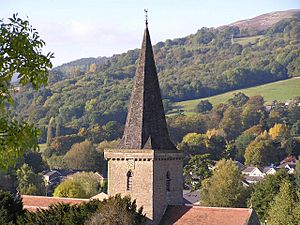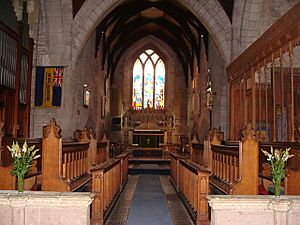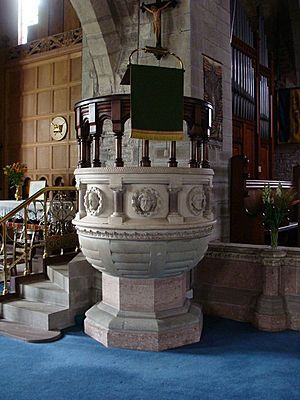St Edmund's Church, Crickhowell facts for kids
St Edmund's Church is a historic church found in Crickhowell, a town in southeastern Powys, Wales. It was built a long time ago, in the early 1300s. The church is named after Saint Edmund, who was a king and a martyr. People have called it St Edmund's Church ever since it was first built in 1303. Today, it is recognized as a Grade II* listed building, which means it's a very important historical site.
Church Design and Features
St Edmund's Church used to be much bigger than it is now. In 1765, parts of the church were in bad shape. So, permission was given to remove the two side aisles. These are like long hallways on the sides of the main church area.
The church has a special shape called "cruciform." This means it looks like a cross from above. It has a main area called the nave, a chancel at the east end, and two transepts that stick out like arms. There is also a spire covered in wooden tiles, which is the only one of its kind in the area. This spire holds five bells.
The church is about 34.4 meters long from east to west. It is about 14.5 meters wide from north to south. The main part, the nave, is about 6.1 meters wide. The chancel, where the altar is, is a bit narrower at about 5.2 meters wide.
An old part of the church, called the rood-loft, is still there. It is now used as a belfry, which is where the bells are kept. The south transept is known as the Rumsey chapel. The north transept is called the Gwernvale chapel. These chapels were once connected to important local families.
Over the years, many changes have been made to the church. This means that most of its very old features are now gone. However, there is still one old window at the west end. It is a lancet window with three sections, located right above the main entrance door. The font, which is used for baptisms, is newer. It has the date 1668 carved on it, along with the names of the church wardens from that time.
Historical Monuments
Inside the church, you can find some interesting old monuments. In the south wall of the chancel, there is a stone monument. It has a damaged figure of a knight lying down. This knight is wearing mail armour, which is a type of old metal suit. The shield on the monument shows that the knight was from the Pauncefote family. There is also some writing on the monument, but it is too old to read clearly.
Across from the knight, in the north wall, there is another similar monument. This one has a figure of a woman. She is probably the knight's wife and is dressed in clothes from that time. The entrances to these burial places were originally outside the church. They were later sealed up with stones. There are two other empty arches like these in the chancel.
On the north side of the chancel, there is a large monument made of black and white marble. It is surrounded by iron railings. On top of it are figures made of alabaster. These figures represent Sir John Herbert and his wife, Joan. Sir John was from a place called Dan y Castell. At one end of this monument, there are two kneeling figures. One is a man, whose head is broken off, dressed like a lawyer from that time. The other is a woman. These figures are for Sergeant Lehunt, who passed away in 1703, and his wife, who passed away in 1694. Near the communion table, there are also inscriptions for Sibil, who was the wife of Edward Herbert.
The church was given its Grade II* heritage listing in 1963. This means it is a very important historical building.
Churchyard Grounds
The churchyard around St Edmund's Church is also a place of history. You can find several old tombstones there. One tombstone remembers Thomas Havard, who passed away in March 1762. Another tombstone, surrounded by iron rails, is for Edward Williams, who passed away on November 30, 1754. In the same churchyard, there is a tombstone for Samuel Walbeoffe, who was buried in 1750.





